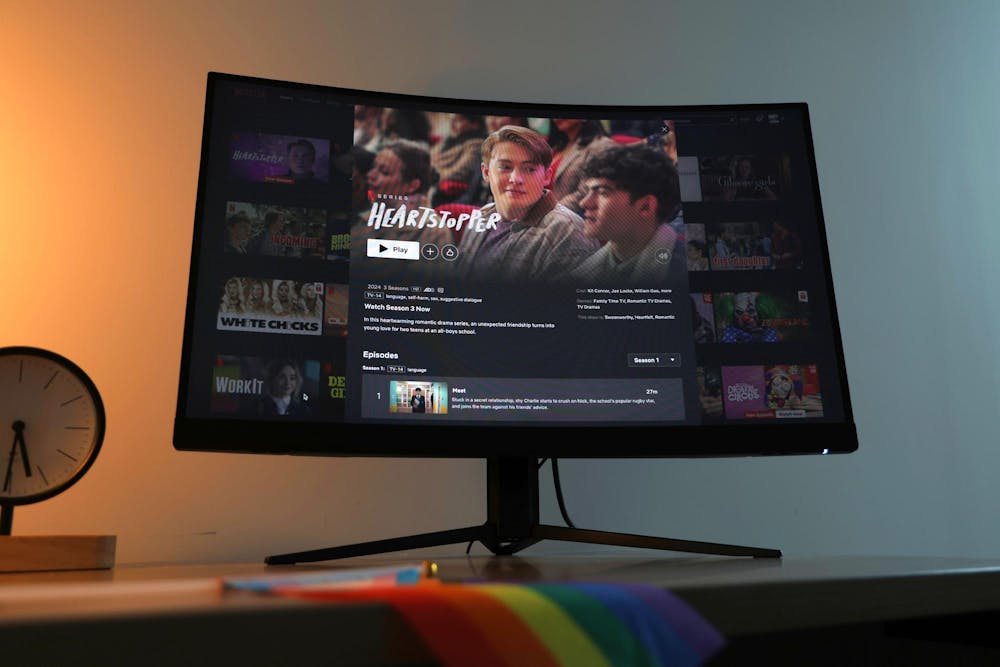Content warning: This article contains discussion of self-harm and eating disorders
TV Show: Heartstopper season three
Release Date: Oct. 3, 2024
Director: Andy Newbery
Episodes: 8
Genre: Romance
Rating: A

"Heartstopper" season three is jam-packed with highs and lows tailored to a more mature audience than the first two seasons.
The Netflix show is based on the "Heartstopper" comic, which came out in 2016. Season three, like past seasons, follows the plot and general timeline of the comic.
In the first two seasons, the main characters, Nick and Charlie, meet and fall in love. Season three continues to develop their relationship but with greater focus on mature themes such as physical intimacy in a LGBTQIA+ relationship and mental health.
In season three, Charlie seeks help for his eating disorder and Obsessive Compulsive Disorder. As Charlie recovers, he grows closer to his boyfriend, Nick emotionally and physically. Nick also begins exploring college options.
Season three is also the first time the actors curse in the show — something that wasn’t allowed in the first two seasons.
While seasons one and two made references to Charlie’s previous self harm and current disordered eating, these issues come to a head in season three. The audience sees Charlie’s mental health put a strain on his relationship with his family, friends and Nick.
Seeing Charlie struggle to reach out, acknowledge his mental illness and change his relationship with his body could be triggering for some viewers.
While tackling this sensitive material, season three is careful to omit content that could be especially harmful, unlike some other shows that cover teenage mental health. "13 Reasons Why", for example shows graphic scenes of self harm and bullying. In "Heartstopper" season three, viewers don’t actually see any acts of self harm, and the conversation around mental health is respectful.
The show acknowledges the nuance of mental health struggles by making it clear that recovery is not linear or immediate, and different strategies work for different people.
A few key plot points that strayed from the comics were that another main character came out as nonbinary and certain characters continue to explore their sexualities.
Isaac, who is Charlie’s friend, in particular questions how his asexual and aromantic identities impact how he sees relationships, especially since most of his friends are getting into romantic relationships. The representation of these sexualities add more nuance into the show's celebration of LGBTQIA+ identities and relationships.
Another notable difference between the comics and the third season is that Elle, an transgender character, experiences transphobia in the TV series. Her experience, while upsetting, effectively places "Heartstopper" in the context of today’s society.
Perhaps the most noticeable deviation of third season from the comics, though, is that season three opens on Charlie's older sister Tori, who has been the first character at Charlie’s side to help him through mental health struggles throughout the first two seasons. Representing Tori struggling with her worry for and devotion to her brother made the new season more three-dimensional than it would have been without the perspective of his family.
Like Tori, Nick struggles to support Charlie while also prioritizing himself. Often, pop culture portrayals of teenage mental health create unrealistic expectations for troubled teenagers to be supposedly cured of their mental health struggles just by being in a romantic relationship. While "Heartstopper" season three depicts a near-best-case scenario of recovery from trauma, it doesn’t put unrealistic pressure on teenage characters to solve those problems by themselves or villainize parental figures.
After a few time skips, the second half of the season shifts to show Charlie and Nick seeking to take their relationship to the next level of physical intimacy. This dramatic shift can be jarring to viewers, but Charlie’s mental health journey is not brushed aside or forgotten in the process. Instead, viewers get to see Charlie slowly but surely get comfortable facing his mental illness while also living a fulfilling life.
"Heartstopper" season three continues the first two seasons’ celebration of LGBTQIA+ love, while representing multiple facets of the LGBTQIA+ community. It represents different sexualities, different kinds of relationships, different experiences in the professional world and more. "Heartstopper" has been and continues to be a celebration of proud, LGBTQIA+ youth.

